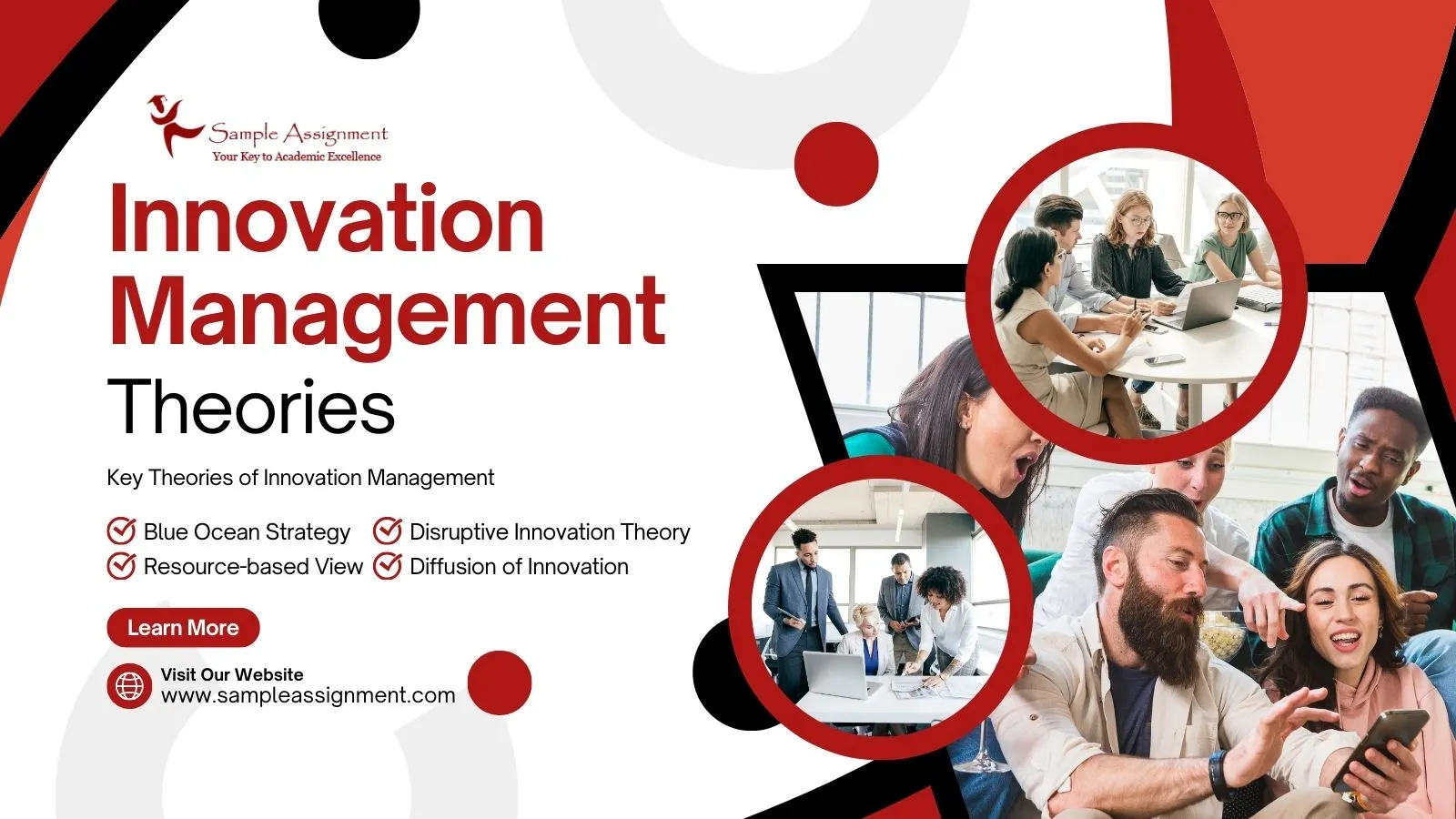
Innovation management is a very important concept in the modern business board. It involves symptomatically managing an organization’s innovation process from ideation to execution. However, understanding and applying innovation management theories can provide businesses with a significant competitive advantage. For students delving into the subject and mastering the theories, the framework of innovation management is a key to academic and professional success. This article explores essentially innovation management theories, their application in the business world, and how students can increase their knowledge with management assignment help services.
What is Innovation Management?
Innovation management refers to the established technique of fostering creativity, developing new ideas, and implementing them within an employer to improve the product, offerings, or strategies. It integrates device strategies and strategies that permit corporations to reply efficiently to marketplace adjustments, consumer needs, and technological improvements.
Students and people who are analyzing the problem need to apprehend new simplest theoretical frameworks along with realistic applications. This understanding is very important for solving complex case studies, drafting comprehensive assignments and excelling in their related academic task. However, some may find it challenging. Therefore, seeking management assignment help from experts can make this easy and worthwhile.
Key Theories of Innovation Management
There are a number of theories developed in innovation management that students must understand and guide innovation management. However, these are challenging for them due to complex terms and technical learning involved. Therefore, seeking management assignment help from experts can provide aid and ease the burden quickly.
Here are some of the most innovation management theories that management assignment help experts can explain well:
1. Disruptive Innovation Theory (Clayton Christensen)
This theory emphasises how smaller companies with fewer resources can challenge established businesses by introducing innovative products or services that initially survive the market by eventually disrupting the mainstream. But due to its complexity students fail to explain it well and seek management assignment help providers assistance.
Example: The rise of streaming services like Netflix disrupted the traditional DVD rental and cable television industries.
Academic Insights: Understanding disruptive innovation helps students analyse case studies and product industry trends, making it a vital theory for management students.
2. Blue Ocean Strategy(Chan Kim and Ranee Mauborgne)
This theory focuses on creating uncontested market spaces rather than competing in Saturated markets. Businesses can achieve this way, offering innovative value propositions.
Example: Cirque du Soleil revolutionise the circus industry by blending theatre and traditional surface elements, creating a unique entertainment category. However, due to technical terms in it, students avail of management assignment help providers assistance.
Academic Insight: Student of an analyst. Business case studies using spring work to identify strategic opportunities for innovation.
3. Diffusion of Innovation(Everett Rogers)
Rogers's theory explains how innovations are adapted over time by different groups within a population. The adoption curve includes investors, early adopters, early majority, late majority and laggards. It is challenging for the students studying innovation management therefore they reach out to management assignment help provider experts.
Example: The adoption of smartphones illustrated the diffusion curve from early adopters to widespread acceptance.
Academic Insights: This theory is useful for assignments that require analysing market penetration and customer behaviour.
4. Resource-based View
The resource-based view suggests that the iPhone's resources and capabilities are the primary drivers of competition and emphasises the role of unique assets such as patents, skilled employees and organizational culture info starring innovations.
Example: Google's culture of innovation and its highly skilled workforce contribute to Its sustained leadership in the tech industry.
Academic Insights: Students can use a resource-based view to assess organisational strength and develop innovation strategies in their assignments.
Role of Leadership in Innovation Management
Effective leadership is very important for driving innovations. Innovation leaders inspire creativity, encouraging risk-taking and building a culture that supports experimentation. The following leadership styles are often associated with successful innovation management:
1. Transformational Leadership
Inspire employees to exceed expectations by focusing on work visions, motivation, and personality development. Understanding these by seeking experts who provide management assignment help becomes easy and quick.
2. Servant Leadership
Prioritise the needs of the team and foster a supportive environment for innovation.
3. Democratic Leadership
Involves employees in decision-making, encouraging Tiger's perspectives and ideas.
In assignments related to leadership and innovation, students are often tasked with analysing real-world leaders which is daunting for them. So, they end the task by availing of management assignment help from experts.
The Role of Technology Innovation Management
Technology plays a very important role in driving innovation management services, both as a catalyst and an enabler for creative processes. Modern businesses leverage advanced tools and platforms just to be online their innovation processes ensure ideas transition seamlessly from conception to execution.
Digital Transformation and Innovation
Digital transformation has revolutionised how organizations approach innovation. Companies use technologies like artificial intelligence, Internet of Things and blockchain to create matter more efficient systems, for example:
1. Artificial Intelligence
Used for predictive analysis, AI helps companies identify trends, understand customer behaviours, and tailor innovative solutions accordingly.
2. Internet of Things
IoT enables real-time data collection and analysis, facilitating process innovations in sectors like manufacturing and logistics.
3. Blockchain
Known for its security and transparency, blockchain drives innovation in finance, supply chain management, and healthcare.
Students studying innovation management often encounter assignments requiring them to evaluate the role of such technologies in transforming business models.
Cultural Factors in Innovation Management
Organizational culture is a very important determinant of innovation success. A culture that encourages experimentation tolerates failure, and values employee input is more likely to foster continuous innovation. These are often challenging for the students to grasp. So, they seek management assignment help providers who have professionals to explain these well and draft efficiently.
Key cultural elements of innovation that management assignment writing experts can explain well include the following:
1. Collaboration
Cross-functional teams with diverse skill sets often generate more creative solutions.
2. Psychological Safety
Employees should feel secure in proposing board ideas without fear of repercussion.
3. Recognitions and Awards
Celebrating innovation efforts boosts employee Morale and inspires others to contribute.
Case studies of companies like Google and 3M illustrate how fostering an innovation-friendly culture can lead to sustained competitive advantage.
Emerging Trends in Innovation Management
The period of innovation management continues to evolve with emerging trends that reshape business strategies. Researching them and drafting them efficiently in assignments is stressful for students. So, they reach out to experts and avail of “management assignment help” to score the highest for their work.
The key trends that these professionals can explain well include:
1. Sustainable innovation
Companies are increasingly prioritising eco-friendly innovations to address climate change and meet customer demand for sustainable products.
2. Crowdsourcing
Averaging collective intelligence business invites external contributions to solve complex problems.
3. Agile Innovation
Adopting an agile methodology enables the company to adapt quickly to changing market conditions and customer requirements.
Understanding these trends prepares students to address future challenges and opportunities in the dynamic field of innovation management.
Challenges in Innovation Management
Innovation management is not without its challenges. Understanding these and availing of management assignment help is very important for developing effective strategies to overcome them.
1. Resistance to Change
Employees often resist innovation due to fear of job displacement or lack of understanding.
2. Resource Constraints
Limited budget and time can hinder innovation efforts.
3. Lack of Collaboration
Different departments can stifle the flow of ideas and impair innovation.
4. Market Uncertainty
Predicting customer needs and market trends is inherently risky.
Assignments on innovation management frequently require students to propose solutions to these challenges. Using management assignment help, you can provide valuable guidance in tackling such complex topics.
Practical Application of Innovation Management Theories
Theories of innovation management are not just academic concepts. They have real-world applications that shape industries. Understanding these applications increases student's ability to connect theory with practice.
1. Product Development
Companies like Apple use innovation theories to create groundbreaking products like the iPhone.
2. Process Innovation
Toyota's Lean manufacturing system incorporates continuous improvement principles to optimise the process.
3. Strategic Planning
Amazon leverages Blue Ocean strategy principles to expand into new markets, such as cloud computing with AWS.
Students can use case studies from these organizations to illustrate theoretical concepts in their assignments, demonstrating a deep understanding of innovation management.
Conclusion
Vision management theories provide a robust framework for understanding and driving creativity in organizations. From disruptive innovation to open innovation, these models guide businesses in navigating competitive markets and fostering growth. For students, mastering these theories not only ensures academic success but also prepares them for leadership roles in the business world by leveraging resources like online assignment help. With these theories in the real-world scenario, students can excel in their studies and make meaningful contributions to the field of innovation management.
FAQs
What is the main objective of innovation management theories?
Innovation management theory seems to provide frameworks for fostering creativity, implementing innovative ideas and achieving organisational goals efficiently.
How can students apply innovation management theories in their assignments?
Students can apply these theories by analysing case studies, proposing innovative strategies for businesses, and demonstrating practical application of theoretical concepts.
Why is leadership important in innovation management?
Leadership offers a culture of innovation within an organization, motivating teams to take race collaborative and achieve breakthrough results.
How does management assignment help you benefit students studying Innovation Management?
Management Assignment Help offers expert guidance, comprehensive research and structure solutions enabling students to excel in complex topics in meet academic requirements effectively.
What is the difference between disruptive innovation and open innovation?
Disruptive innovation focuses on creating new markets of disrupting existing ones with breakthrough products or services global innovation emphasises collaboration with external stakeholders to increase creativity and innovation.










Loved reading this Blog? Share your valuable thoughts in the comment section.
Add comment